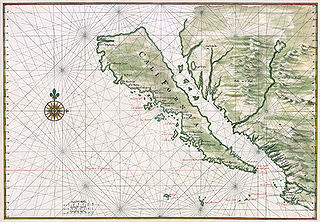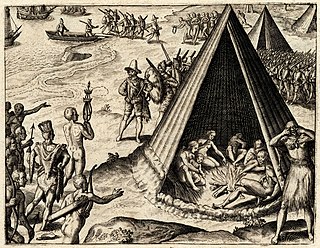Related Research Articles

Sir Francis Drake was an English explorer, sea captain, slave trader, privateer, naval officer, and politician. Drake is best known for his circumnavigation of the world in a single expedition, from 1577 to 1580. This included his incursion into the Pacific Ocean, until then an area of exclusive Spanish interest, and his claim to New Albion for England, an area in what is now the American state of California. His expedition inaugurated an era of conflict with the Spanish on the western coast of the Americas, an area that had previously been largely unexplored by Western shipping.

Sir Martin Frobisher was an English seaman and privateer who made three voyages to the New World looking for the North-west Passage. He probably sighted Resolution Island near Labrador in north-eastern Canada, before entering Frobisher Bay and landing on present-day Baffin Island. On his second voyage, Frobisher found what he thought was gold ore and carried 200 tons of it home on three ships, where initial assaying determined it to be worth a profit of £5.20 per ton. Encouraged, Frobisher returned to Canada with an even larger fleet and dug several mines around Frobisher Bay. He carried 1,350 tons of the ore back to England, where, after years of smelting, it was realised that the ore was a worthless rock called hornblende. As an English privateer, he plundered riches from French ships. He was later knighted for his service in repelling the Spanish Armada in 1588.
Kake is a first-class city in Prince of Wales-Hyder Census Area, Alaska, United States. The population was 557 at the 2010 census. The name comes from the Tlingit word Ḵéix̱ʼ or Ḵéex̱ʼ, which is derived from ḵée 'dawn, daylight' and x̱ʼé 'mouth', i.e. 'mouth of dawn' or 'opening of daylight'.

The Río de la Plata, called River Plate in British English and the Commonwealth and La Plata River in other English-speaking countries, is the estuary formed by the confluence of the Uruguay River and the Paraná River at Punta Gorda. It empties into the Atlantic Ocean and forms a funnel-shaped indentation on the southeastern coastline of South America. Depending on the geographer, the Río de la Plata may be considered a river, an estuary, a gulf, or a marginal sea. It is the widest river in the world, with a maximum width of 220 kilometres (140 mi).

Golden Hind was a galleon captained by Francis Drake in his circumnavigation of the world between 1577 and 1580. She was originally known as Pelican, but Drake renamed her mid-voyage in 1578, in honour of his patron, Sir Christopher Hatton, whose crest was a golden hind. Hatton was one of the principal sponsors of Drake's world voyage. A full-sized, seaworthy reconstruction exists in London, on the south bank of the Thames.

The Island of California refers to a long-held European misconception, dating from the 16th century, that the Baja California Peninsula was not part of mainland North America but rather a large island separated from the continent by a strait now known as the Gulf of California.

New Albion, also known as Nova Albion, was the name of the continental area north of Mexico claimed by Sir Francis Drake for England when he landed on the North American west coast in 1579. This claim became the justification for English charters across America to the Atlantic coast and soon influenced further national expansion projects on the continent. Today, Drake's landing site is known as Point Reyes, California, a marine environment which is the setting of several small towns, ranches, and Point Reyes National Seashore.

Whale Cove is a small cove, approximately one-third of a mile (0.5 km) in diameter, located on the Pacific Coast of Oregon in the United States, approximately 1.4 mi (2.3 km) south of the city of Depoe Bay. The cove is located at approximately 44 deg 44 min N latitude.
The Age of Discovery, or the Age of Exploration, is an informal and loosely defined term for the early modern period approximately from the 15th century to the 18th century in European history, in which sea-faring European nations explored regions across the globe.

The Comox Valley is a region on the east coast of Vancouver Island, British Columbia, Canada, that includes the city of Courtenay, the town of Comox, the village of Cumberland, and the unincorporated settlements of Royston, Union Bay, Fanny Bay, Black Creek and Merville. The communities of Denman Island and Hornby Island are also considered part of the Comox Valley. The Comox Valley contains the 47th largest metropolitan area in Canada with a population of about 66,000 as of 2016.

Ferdinand Magellan was a Portuguese explorer who organised the Spanish expedition to the East Indies from 1519 to 1522, resulting in the first circumnavigation of the Earth, which was completed after his death in the Philippines by Juan Sebastián Elcano.
La Princesa was a Spanish frigate or corvette built at the Spanish Navy base at San Blas and launched in 1778. She is sometimes called a frigate and sometimes a corvette. At the time a corvette was similar to a frigate in that both were three-masted, ship-rigged warships, but corvettes were slightly smaller and had a single deck instead of two. The exact specifications of La Princesa are not known. La Princesa was designed with storage enough to sail for a year without having to restock. She was built for durability rather than speed. Like La Favorita, a similar corvette stationed at San Blas, La Princesa was heavily used, serving for over three decades, playing an important role in the exploration of the Pacific Northwest as well as the routine work of provisioning the missions of Alta California. During her 1779 voyage the Princesa carried six four-pounder cannons and four three-pounders, and had a crew complement of 98. The Princesa carried 26 cannons in 1789 when Esteban José Martínez took control of Nootka Sound.

Polynesians reached nearly all the Pacific islands by about 1200 AD, followed by Asian navigation in Southeast Asia and West Pacific. Around the Middle Ages Muslim traders linked the Middle East and East Africa to the Asian Pacific coasts. The direct contact of European fleets with the Pacific began in 1512, with the Portuguese, on its western edges, followed by the Spanish discovery of the Pacific from the American coast.
From 1577 to 1580 Sir Francis Drake circumnavigated the world. In 1579 as part of this voyage he landed on the west coast of North America which consequently has drawn the attention of scores of historians, geographers, linguists, anthropologists and other professionals. In addition, many history buffs have sought to locate Drake's New Albion. The accepted site for Drake's 1579 landing at New Albion is at Drake's Cove in Drakes Bay in Marin County, California. More than a score of ideas have been put forth—covering the coast from Alaska to Baja California Sur, Mexico. These ideas span the eighteenth through the early twenty-first centuries.

The Capture of Santiago was a military engagement that took place between 11–28 November 1585 during the newly-declared Anglo-Spanish War. An English expedition led by Francis Drake captured the port town of Cidade Velha in the Cape Verde islands that had recently belonged to the Crown of Portugal. He sacked it and then marched inland before doing the same at São Domingos and Praia. Afterwards Drake left and continued his expedition to successfully raid the Spanish possessions in the Americas.

The Newfoundland Expedition also known as Bernard Drake's Newfoundland Expedition was an English naval expedition that took place during the beginning of the declared Anglo-Spanish War in the North Atlantic during summer and autumn of 1585. The area of conflict was situated mainly in an area known as the Grand Banks off present day Newfoundland. The aim of the expedition was to capture the Spanish and Portuguese fishing fleets. The expedition was a huge military and financial success and virtually removed the Spanish and Portuguese from these waters. In addition the raid had large consequences in terms of English colonial expansion and settlement.

Drake's Assault on Panama also known as the Defence of Panama was a military event that took place in January 1596 during the Anglo–Spanish War. An English expedition under the command of Francis Drake and Thomas Baskerville attacked the Spanish Main via Nombre de Dios in order to cross the isthmus of Panama. Ravaged with dysentery and other diseases the English were repelled and defeated. Drake would die of the former and the expedition was forced to retreat back to England all the while harassed by the Spanish.

Francis Drake's circumnavigation, also known as Drake's Raiding Expedition, was an important historical maritime event that took place between 15 December 1577 and 26 September 1580. Authorised by Queen Elizabeth I and led by Francis Drake; the latter sailed with five ships in what was termed a 'voyage of discovery', although in effect it was an ambitious covert raiding voyage and the start of England's challenge to Spain's global domination.

Thomas Cavendish's circumnavigation was a voyage of raid and exploration by English navigator and sailor Thomas Cavendish which took place during the Anglo–Spanish War between 21 July 1586 and 9 September 1588. Following in the footsteps of Francis Drake who having circumnavigated the globe, Thomas Cavendish was influenced in an attempt to repeat the feat. As such it was the first deliberately planned voyage of the globe.
References
- ↑ John Logan Allen (1997). North American Exploration. U of Nebraska Press. pp. 433–. ISBN 0-8032-1015-9.
- ↑ Dora Polk (January 1965). The Island of California: A History of the Myth. U of Nebraska Press. pp. 221–. ISBN 0-8032-8741-0.
- ↑ Samuel Bawlf (1 September 2009). The Secret Voyage of Sir Francis Drake. D&M Publishers Incorporated. pp. 331–. ISBN 978-1-926706-24-5.
- ↑ Harry Kelsey (2000). Sir Francis Drake: The Queen's Pirate. Yale University Press. pp. 194–. ISBN 978-0-300-08463-4.
- ↑ The Secret Voyage of Sir Francis Drake
- ↑ Charles F. Lumis, ed. (1900). "Narrative of the Pilot Morera, who passed through the North Sea to the South Sea through the Strait". The Land of Sunshine, the Magazine of California and the West (February). pp. 184–186.
- ↑ Aker, Raymond (1970). REPORT OF FINDINGS RELATING TO THE IDENTIFICATION OF SIR FRANCIS DRAKE'S ENCAMPMENT AT POINT REYES NATIONAL SEASHORE (PDF). pp. 338–340.